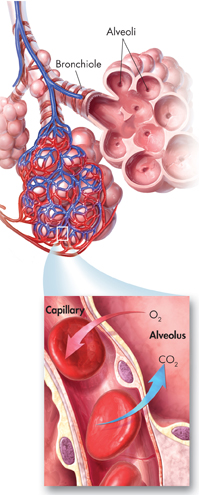Gas Exchange and Transport
 How are oxygen and carbon dioxide exchanged and transported throughout the body?
How are oxygen and carbon dioxide exchanged and transported throughout the body?
Each healthy lung contains about 150 million alveoli, which provide an enormous surface area for gas exchange.  Oxygen and carbon dioxide are exchanged across the walls of alveoli and capillaries. Chemical properties of blood and red blood cells allow for efficient transport of gases throughout the body.
Oxygen and carbon dioxide are exchanged across the walls of alveoli and capillaries. Chemical properties of blood and red blood cells allow for efficient transport of gases throughout the body.
Gas Exchange When air enters alveoli, oxygen dissolves in the moisture on their inner surface and then diffuses across thin capillary walls into the blood. Oxygen diffuses in this direction because the oxygen concentration is greater in the air within the alveoli than it is in the blood within the capillaries. Meanwhile, carbon dioxide diffuses from blood into the alveoli because its concentration is greater in the blood than it is in the air in the alveoli. The process of gas exchange is illustrated in Figure 33–16.
The air you inhale usually contains 21 percent oxygen and 0.04 percent carbon dioxide. Exhaled air usually contains less than 15 percent oxygen and 4 percent carbon dioxide. This means your lungs remove about a fourth of the oxygen in the air you inhale and increase the carbon dioxide content of that air by a factor of 100.

FIGURE 33–16 Gas Exchange Carbon dioxide and oxygen diffuse across capillary and alveolus walls. Draw Conclusions Where is oxygen more concentrated, in an alveolus or in a capillary?
dTransport Hemoglobin binds with and transports oxygen that diffuses from alveoli to capillaries. It also increases the efficiency of gas exchange. Diffusion of oxygen from alveoli into capillaries is a passive process. That process stops when oxygen concentration in the blood and alveoli is the same. But hemoglobin actively binds to dissolved oxygen, removing it from plasma and enabling diffusion from the alveoli to continue. Hemoglobin binds with so much oxygen that it increases blood's oxygen-carrying capacity more than 60 times.
When carbon dioxide diffuses from body tissues to capillaries, it is transported in the blood in three different ways. Most carbon dioxide enters red blood cells and combines with water, forming carbonic acid. The rest of it dissolves in plasma or binds to hemoglobin and proteins in plasma. These processes are reversed in the lungs, where carbon dioxide is released into alveoli and exhaled.
 In Your Notebook What would happen to the surface area for gas exchange if a disease caused the walls between alveoli to break down?
In Your Notebook What would happen to the surface area for gas exchange if a disease caused the walls between alveoli to break down?
Breathing
 What mechanisms are involved in breathing?
What mechanisms are involved in breathing?
Surprisingly, there are no muscles in our lungs or connected directly to them that participate in breathing. The force that drives air into the lungs comes from ordinary air pressure, the diaphragm, and muscles associated with the ribs.  Movements of the diaphragm and rib cage change air pressure in the chest cavity during inhalation and exhalation.
Movements of the diaphragm and rib cage change air pressure in the chest cavity during inhalation and exhalation.
Table of Contents
- Formulas and Equations
- Applying Formulas and Equations
- Mean, Median, and Mode
- Estimation
- Using Measurements in Calculations
- Effects of Measurement Errors
- Accuracy
- Precision
- Comparing Accuracy and Precision
- Significant Figures
- Calculating With Significant Figures
- Scientific Notation
- Calculating With Scientific Notation
- Dimensional Analysis
- Applying Dimensional Analysis




